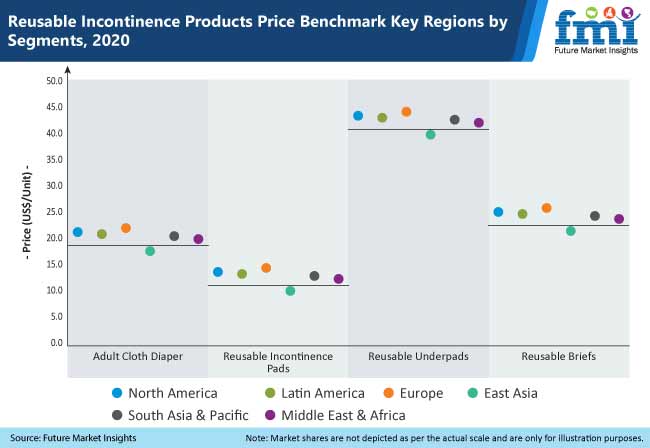Research Reports
Reusable Incontinence Products Market Research 2021 Focusing on Key Companies, Development, Trends, Challenges, Growth, Countries, Revenue & Forecast to 2031

Conventionally, disposable incontinence products have dominated the industry. The recent wave of sustainability has transformed the prevailing dynamics, shifting consumer inclination from disposable and easy-to-use products to washable, reusable, and environment-friendly products. This trend has proven crucial in enabling growth in the reusable incontinence products market. Future Market Insights (FMI) in a new study has forecast the market to reach US$ 616.9 Mn in 2021.
Modern absorbent hygiene products (baby diapers, adult incontinence and feminine hygiene products) improve quality of life, provide great protection, and can support the skin health of millions of people; however, at the cost of environment.Absorbent hygiene products (AHPs) have become essential everyday products to society and their use has increased substantially.
The incontinence system waste consists of approximately 53% water, 30% wood fiber, 11% plastic, 2% Super Absorbent Polymer (SAP) and 4% feces and other material. Through the recovery of fibres, plastics and super-absorbing polymers, the implementation of waste treatment technology is a clear example of sustainable development. In a bid to lessen the burden of waste accumulation, manufacturers have adopted the equally efficient but more sustainable approach involving use of reusable incontinence products, thus driving the market demand further.

Focus on Sustainability to Have Considerable Impact
Manufacturers are aligning the development of products with a sustainable approach to gather an audience.Brands suggest mix-and-match use of reusable as well as disposable products to improve the sustainability quotient of the approach towards battling incontinence, without compromising on efficiency and convenience associated with the use of products.
Natural claims have, apart from being important product purchase drivers when combined with product efficacy claims and brand identity, triggered the sustainability quotient. Consumers also have begun demanding full transparency from personal care product manufacturers on their sourcing methods, product, ingredients and sustainability practices. The pressure on these brands and manufacturers to demonstrate their social and environmental credentials is increasing; so more of them are finding ways to transform their own brands through sustainability-focused products, services and consumer experiences.
NHS Inform (2020) estimates that three million to six million people in the UK experience urinary incontinence and that demand for continence products is likely to rise because risk factors for incontinence are increasing. It also emphasizing on reduce, reuse and recycle approach.
This change in consumer buying preference has encouraged the players in the market to stimulate innovation and expand the portfolio, tapping the unexposed segments of the industry and as a result escalating the demand over the forecast period.
In terms of product type, reusable briefs account for a notable share, followed by reusable incontinence pads. Reusable pads and liners are economically viable and can be effectively used along with the normal underwear; hence, the growing demand.
Key Takeaways from the Reusable Incontinence ProductsMarket Study
- Reusable incontinence products sales to surge at a consistent pace, exhibiting 5.9% CAGR between 2021 and 2031
- Rising cases of urinary incontinence fuelling sales in the U.S., which will account for nearly 85% of North America market
- Increasing internet penetration and expansion of online retailing supporting growth in Germany and France
- Rising geriatric population creating lucrative scope for expansion in China
- High cost of incontinence products might remain a key challenge in India
“Manufacturers operating in the market are focusing on offering greater sustainability. Product launches have therefore become common. These are primarily intended to offer improved patient care”says an FMI analyst.
Who is winning?
Key playersin the reusable incontinence productsmarketareKimberly-Clark Corporation, The Proctor & Gamble Company, MediFabrik SRL, Cardinal Health, Inc., Essity AB, Medline Industries, Inc., Ontex International N.V., Attindas Hygiene Partners, Activ Medical Disposable, Paul Hartmann AG, Nexwear, Prime Life Fibers, Royal Medical Solutions, Inc., Abena Group, Unicharm Corporation, Prevail, and Dryloch Technologies NV, among others.
Targeted and unique product offerings are being introduced into the market in order to attract the attention of a specific community. For instance, Depend and Poise brands of Kimberley-Clark developed guards and shields to assist the needs of male sufferers of light bladder leakage deal with the condition. The products are designed to fit a man’s body and can be worn securely in man’s own underwear.
Earlier, men with light bladder leakage were neglected by the industry resulting in the use of products designed initially for women. Such targeted product innovations on the manufacturer’s end have taken the onus for improved personal hygiene across demographics.
For More Details, Ask Analyst @ https://www.futuremarketinsights.com/ask-question/rep-gb-13065
Get Valuable Insights into Reusable Incontinence Products Market
Future Market Insights, in its new offering, provides an unbiased analysis of the global reusable incontinence products market, presenting historical demand data (2016-2031) and forecast statistics for the period from 2021-2031. The study divulges compelling insights on thereusable incontinence productsmarket based on theproduct type (adult cloth diaper, reusable incontinence pads, reusable underpads, and reusable briefs), end user (men, women and kids), price range (mass/ economic and premium), size (small, medium, large and X-large), sales channel (direct sales, hypermarkets/ supermarkets, convenience stores,departmental stores, mono brand stores, specialty stores,drug stores andonline retailing), across seven major regions.
The post Reusable Incontinence Products Market Research 2021 Focusing on Key Companies, Development, Trends, Challenges, Growth, Countries, Revenue & Forecast to 2031 appeared first on Industry News Analsis.








